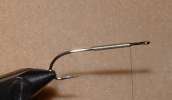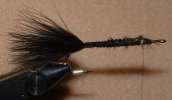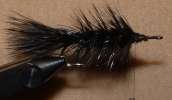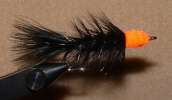
Egg Sucking Leach by Jason Akl
article copyright
As good as the Woolly Bugger has been to fly anglers over the last few decades, the Egg Sucking Leech might just be better. When Will Bauer of McBauer’s Fly Shop in Anchorage first tested this bright-headed bugger on the nearby streams and rivers the result was not what anyone had expected. It was and still is a devastating fish catcher that has the ability to stir even the most lethargic fish and is a proven fish catcher from as far north as Alaska to as far south as Mexico.
The original version was tied with black marabou and hackle. In more recent times the egg-sucking leech has spawned an almost limitless amount of color combinations. The purple version has proven to be one of the more successful of these color combos. This pattern is “standard issue” for any angler fishing for trout and salmon in rivers or lakes.
In lakes, leech patterns coupled with long casts and an erratic sink strip retrieve will attract attention from cruising or resting fish. Trout in this slow moving environment are looking for flies that are life-like, but at the same time produce lots of action. The marabou tail along with saddle hackle provide just what these lethargic fish are looking for, a plump undulating slow moving leech.
If you are fishing streams or rivers the leech is your ticket to more and bigger fish. In the fast current a quick 3 to 4 strip retrieve with intermittent pauses is what will work to get the fish’s attention. If fishing a sandy or muddy river, a good technique is to make 4-5 quick strips and then let the fly drop to the bottom in a cloud of debris. Continue this pattern of swimming then hiding and hang on tight. It will be only be a matter of time before you get a lunker’s attention.
 Start this fly by securing your fly into your vice tightly and attaching the thread behind the hook eye. Place a few wraps of lead free weight around the hook shank to add a little extra weight to get the fly down where the big fish lay.
Start this fly by securing your fly into your vice tightly and attaching the thread behind the hook eye. Place a few wraps of lead free weight around the hook shank to add a little extra weight to get the fly down where the big fish lay.
 Clip a small three inch section of copper wire and wrap it down to the hook shank with the tying thread so that the wire extends off the back of the hook shank. Select a small bushy plume of peacock herl and tie it down to the hook shank so that the tail section is just about the same length as the hook shank. Don’t cut the tag end of the plume; wrap it down onto the hook shank so that it can add a little girth to the body of the fly.
Clip a small three inch section of copper wire and wrap it down to the hook shank with the tying thread so that the wire extends off the back of the hook shank. Select a small bushy plume of peacock herl and tie it down to the hook shank so that the tail section is just about the same length as the hook shank. Don’t cut the tag end of the plume; wrap it down onto the hook shank so that it can add a little girth to the body of the fly.
 Strip the end of the black chenille and the black hackle and tie them both down to the hook shank at the point just above the barb. Wrap the chenille forward in an even manner creating a tapered bushy body and stop at about the 2/3 mark on the hook shank. Counter wrap the black hackle forward up the body of the fly with even spacing being careful not to wrap down any of the proceeding hackle.
Strip the end of the black chenille and the black hackle and tie them both down to the hook shank at the point just above the barb. Wrap the chenille forward in an even manner creating a tapered bushy body and stop at about the 2/3 mark on the hook shank. Counter wrap the black hackle forward up the body of the fly with even spacing being careful not to wrap down any of the proceeding hackle.
 Once the hackle is tied off, wrap the copper wire forward in the same direction that you wrapped the chenille. Be careful not to wrap down any of the hackle that you just warped in the earlier steps. Once again strip the end of the chenille and tie it down to the hook shank. With a few turns of the orange chenille build a large round egg up to the back of the hook eye. Clip the tag end of chenille and whip finish, cement the thread.
Once the hackle is tied off, wrap the copper wire forward in the same direction that you wrapped the chenille. Be careful not to wrap down any of the hackle that you just warped in the earlier steps. Once again strip the end of the chenille and tie it down to the hook shank. With a few turns of the orange chenille build a large round egg up to the back of the hook eye. Clip the tag end of chenille and whip finish, cement the thread.
author website: visit | author bio
![]()


You have good site